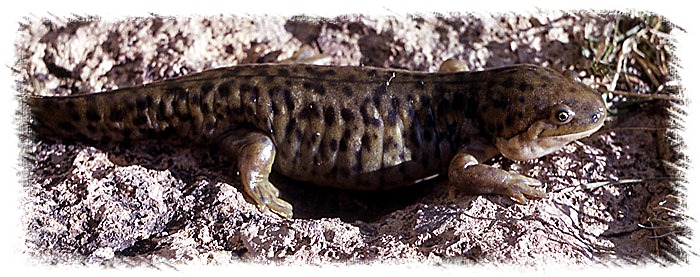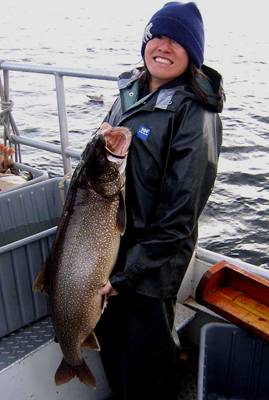

Yellowstone National Park Challenges
Yellowstone National Park's managers face many challenges as they strive to protect wondrous natural resources and provide safe and enjoyable experiences for visitors.
Climate Change

Tiger Salamanders may lose essential habitat as temperatures increase and wetlands dry up.
Yellowstone's ecosystems will likely change as climate change advances. Scientists expect increased temperatures and changing rain and snow patterns in the park. Effects could be:
 The alpine zone, which begins at 9500 feet, may shift higher, with important species like whitebark pine almost entirely lost to the ecosystem.
The alpine zone, which begins at 9500 feet, may shift higher, with important species like whitebark pine almost entirely lost to the ecosystem.
 Wildland fire in the western states generally is expected to intensify. However, scientific research is showing a different possibility in Yellowstone: fires may be more frequent, but smaller and less intense, than today.
Wildland fire in the western states generally is expected to intensify. However, scientific research is showing a different possibility in Yellowstone: fires may be more frequent, but smaller and less intense, than today.
 Increased insect infestations in trees. Currently, two types of pine bark beetles and a spruce budworm are at work.
Increased insect infestations in trees. Currently, two types of pine bark beetles and a spruce budworm are at work.
 Declining wetlands, which will decrease essential habitat for frogs, salamanders, and many birds and insects.
Declining wetlands, which will decrease essential habitat for frogs, salamanders, and many birds and insects.
 Wildlife predictions vary. Bison, elk, and other grassland animals should be able to find suitable habitat. Grizzly bears will have less of their most valuable foods: whitebark pine nuts, army cutworm moths, and cutthroat trout.
Wildlife predictions vary. Bison, elk, and other grassland animals should be able to find suitable habitat. Grizzly bears will have less of their most valuable foods: whitebark pine nuts, army cutworm moths, and cutthroat trout.
Yellowstone National Park Climate research: Available Here.
Lake Trout

One lake trout caught = 41 cutthroat saved.
Yellowstone Lake's native cutthroat trout are severely threatened by lake trout, which are voracious predators of the native trout.
Adult cutthroat trout have always been preyed upon by a variety of native wildlife such as bald eagles, osprey, pelicans, cormorants, gulls, otters, and grizzly bears.
Lake trout cannot be eliminated from Yellowstone Lake. However, park fisheries managers hope to greatly reduce the growth of the lake trout population and recover the cutthroat trout population.
The National Park Service targets lake trout with an intensive gill-netting program that begins after ice is gone from the lake and continues into October. Since the early 1990s, this program has removed more than 450,000 lake trout.
Fishing regulations require anglers to kill all lake trout caught in Yellowstone Lake and its tributaries. Anglers are an important part of lake trout management. Annually, they catch approximately 9,000 lake trout.
To find out more, ask for Yell 300, "Lake Trout," at visitor centers or visit www.nps.gov/yell/planyourvisit/fishing.htm or Fishing Regulations.
Winter Use

Yellowstone National Park and the National Park Service (NPS) are preparing a new longterm plan for managing winter use in America's first national park. The plan will take effect in the winter of 2011–12, when the present two year interim plan expires.
For more than a decade, the question of snowmobile and snowcoach use in the park has provoked intense discussions and debates, as well as numerous lawsuits and court decisions.
A draft Environmental Impact Statement (EIS) for the new long-term plan will be available for public review and comment this spring. Getting involved in Yellowstone National Park's next winter use plan means submitting your comments in person, on paper, or in cyberspace.
Whatever medium you choose, make your ideas and opinions known as this important planning document is prepared.
To stay current on winter-use planning, go to www.nps.gov/yell/planyourvisit/winteruse.htm.
When Buffalo Roam

During winter, bison often migrate to winter range along and outside the park's north and west boundaries. This concerns the livestock industry because some bison carry the disease brucellosis, which is a problem with cattle. A bison management plan is in place to conserve the Yellowstone bison population and minimize or avoid the risk of Yellowstone bison mixing with livestock near the park.
Hazing & Capture
Bison migrating from the park may be hazed to management zones inside or outside the park. When hazing is no longer successful, bison can be captured, and may be sent to slaughter.
Understanding Bison Movement
Managers are studying bison movements to understand when, how, and where they migrate both inside and outside of the park. This may help managers anticipate large herd movements, and to keep bison apart from cattle.
Vaccination
In 2010, the National Park Service (NPS) released the Draft Environmental Impact Statement (DEIS), Remote Vaccination Program for Bison in Yellowstone National Park. The NPS is evaluating public comments and expects to release the final EIS in late 2011.
Bison Hunt
The state of Montana manages a public bison hunt on public lands outside Yellowstone National Park during the late fall and winter. In addition, several tribes exercise their treaty rights to hunt bison outside the park.
Outlook
State and federal agencies will continue to work together to prevent bison-to-cattle transmission. Each agency plays a separate role in managing this population that now has approximately 80,000 acres of habitat in Montana outside Yellowstone National Park.
Information provided by the NPS
| Yellowstone National Park Information Office PO Box 168 Mammoth, WY 82190-0168 |
Yellowstone National Park Superintendent: Cam Sholly
Yellowstone National Park: Contact Page ~ Email Address ~ Phone Numbers


| Yellowstone National Park WebCams | |||
|---|---|---|---|
| Old Faithful Live | All Old Faithful | Old Faithful Static | Old Faithful VC |
| North Entrance | Mt Washburn | Mammoth | YVO WebCam |
| Entrance Cities and Gateway Towns | |||
|---|---|---|---|
| Gardiner, Montana | Silver Gate, Montana | West Yellowstone, Montana | Cooke City, Montana |
| Livingston, Montana | Cody, Wyoming | Jackson Hole, Wyoming | Yellowstone National Park |

| Links | |
|---|---|
| The Great Outdoors Net | Great Outdoor Recreational Places |
| Gardiner, Montana | West Yellowstone, Montana |
 |  |